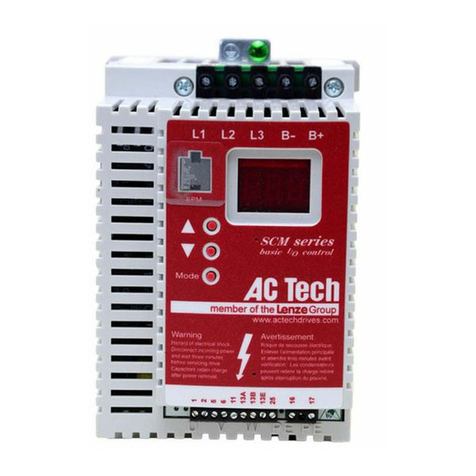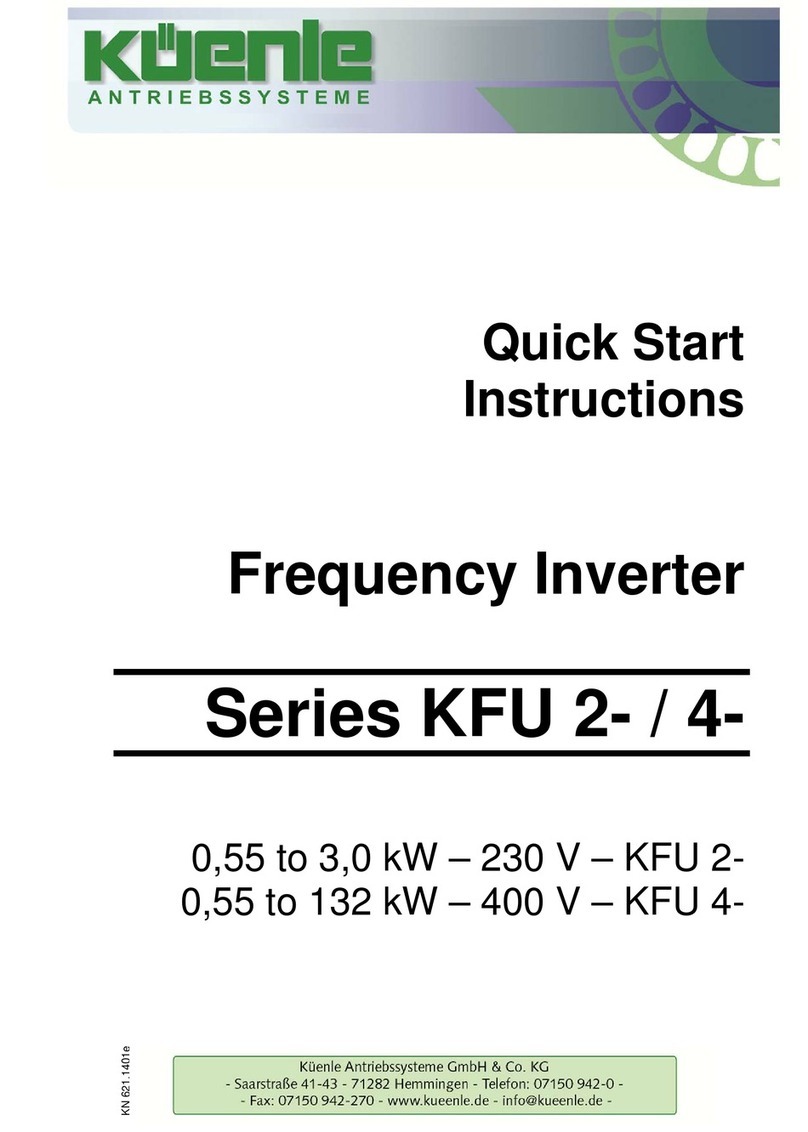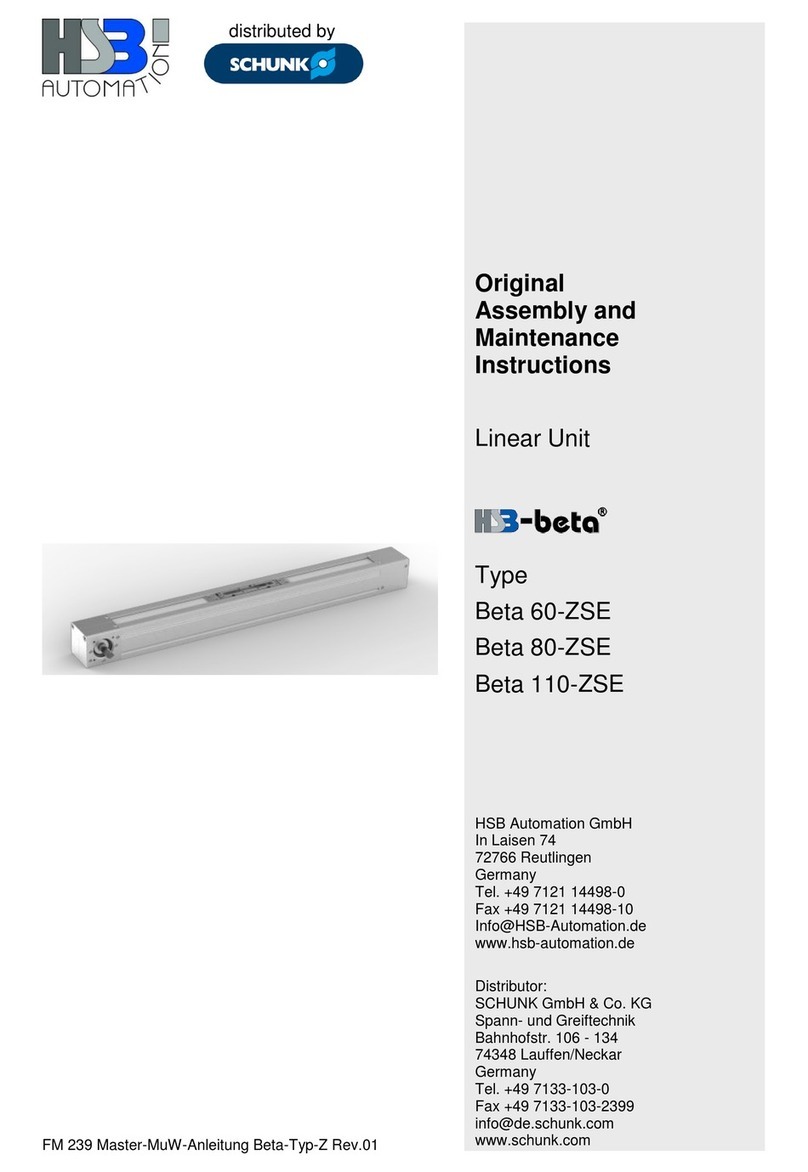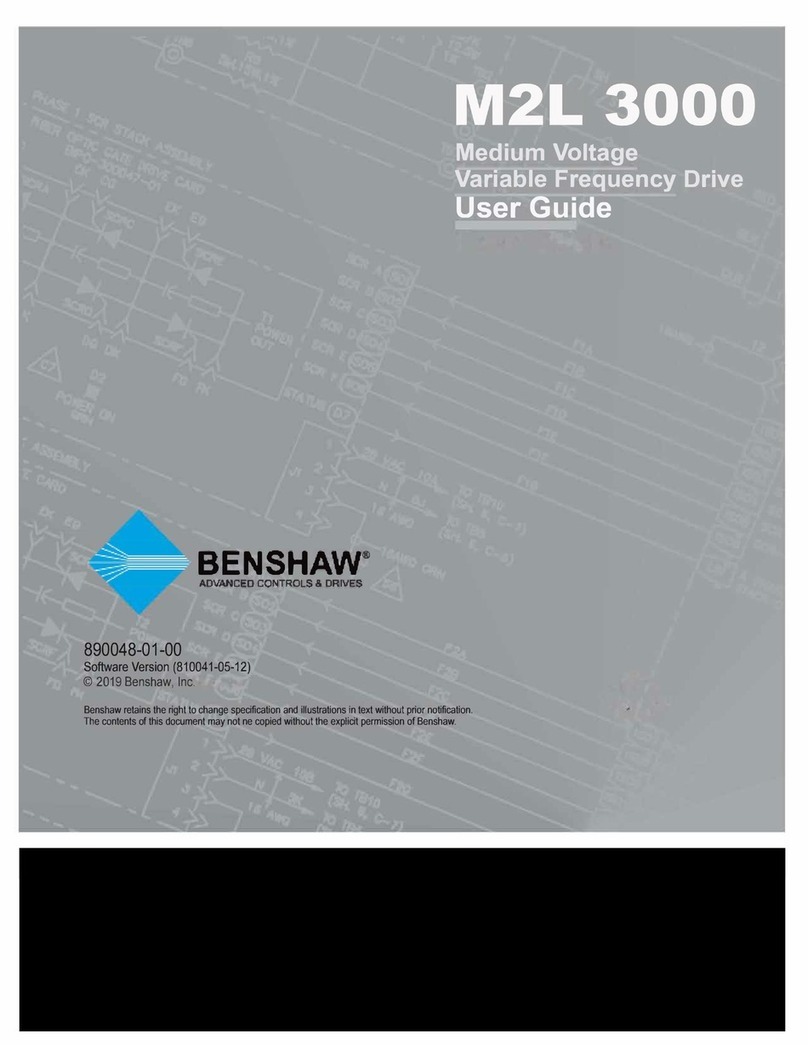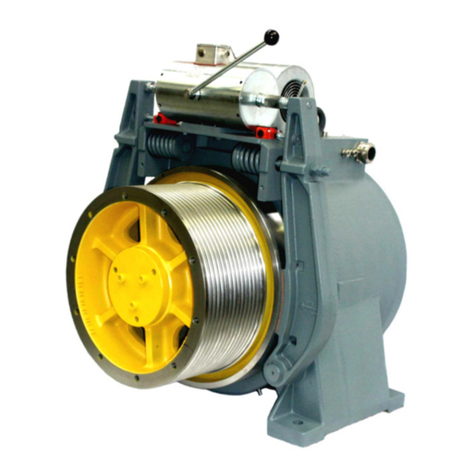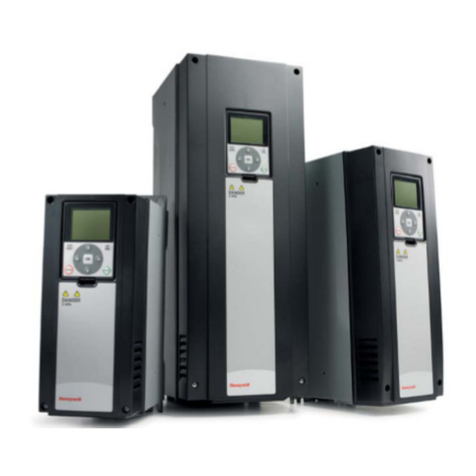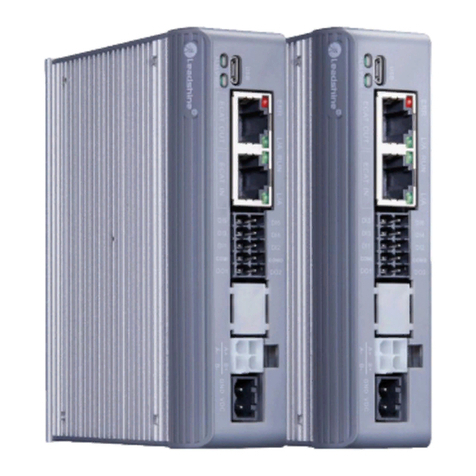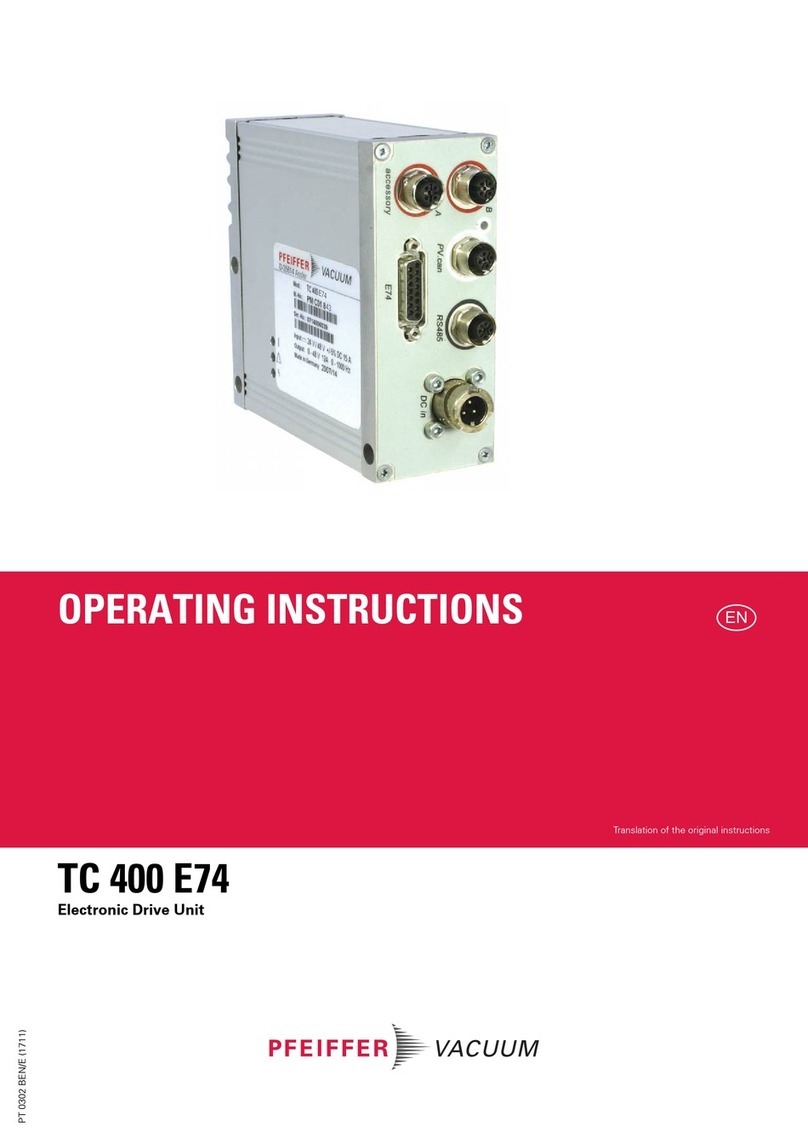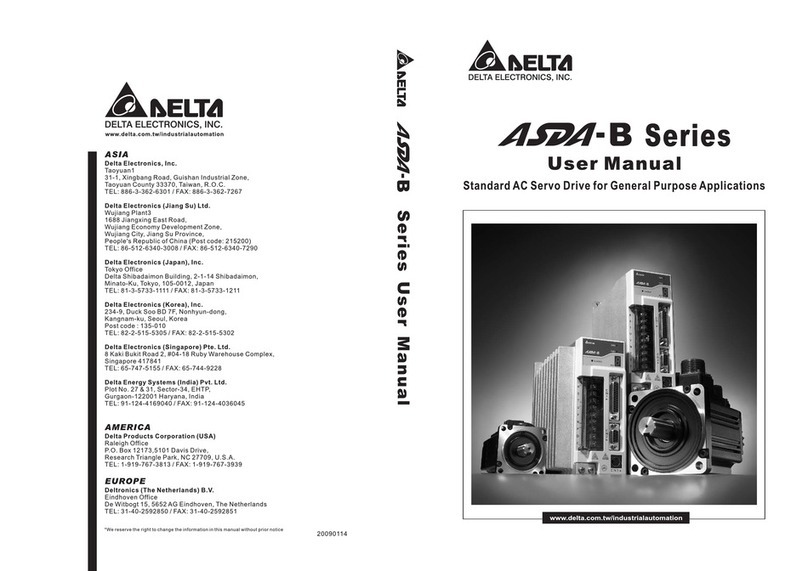AC Tech MC1000 series User manual

InstallationandOperationManual
MC1000 Series

Manual Number: 1001.013.11
TABLE OF CONTENTS
1.0 GENERAL....................................................................................................... 1
PRODUCTS COVERED IN THIS MANUAL.................................................. 1
PRODUCT CHANGES..................................................................................... 1
WARRANTY.................................................................................................... 1
RECEIVING..................................................................................................... 1
CUSTOMER MODIFICATION....................................................................... 1
2.0 MC1000 SPECIFICATIONS........................….............………...........…...... 2
3.0 MC1000 MODEL DESIGNATION CODE.................................…..…........ 3
4.0 MC1000 DIMENSIONS....................................................................….......... 4
5.0 MC1000 RATINGS...........................................................................….......... 8
6.0 THEORY......................................................................................................... 12
DESCRIPTION OF AC MOTOR OPERATION.............................................. 12
DRIVE FUNCTION DESCRIPTION...............................……........................ 14
7.0 INSTALLATION............................................................................................ 18
8.0 INPUT AC REQUIREMENTS...................................................................... 20
9.0 VOLTAGE SELECTION...............................................................................21
10.0 POWER WIRING...........................................................................................22
11.0 MC1000 POWER WIRING DIAGRAM.......................................................23
12.0 INITIAL POWER UP.....................................................................................24
13.0 KEYPAD CONTROL.....................................................................................26
KEYPAD FUNCTIONS......................................................................…..........26
MC1000 DISPLAY.............................................................................…..........27
14.0 CONTROL WIRING......................................................................................32
GENERAL........................................................................................................32
START/STOP AND SPEED CONTROL......................................................... 33
15.0 MC1000 CONTROL WIRING DIAGRAMS................................................39
MC1000 TERMINAL STRIP........................................................................... 39
TWO-WIRE START/STOP CONTROL.......................................................... 40
THREE-WIRE START/STOP CONTROL...................................................... 41
SPEED POT AND PRESET SPEED CONTROL.............................................42
16.0 PROGRAMMING THE MC1000 DRIVE.................................................... 43
PROGRAMMING THE PARAMETERS.........................................................43
PARAMETER ACCESS USING SPEED DIAL...............................................45
17.0 PARAMETER MENU.................................................................................... 46
18.0 DESCRIPTION OF PARAMETERS............................................................ 49
19.0 TROUBLESHOOTING..................................................................................74
20.0 USER SETTING RECORD............................................................................76

1
1.0 GENERAL
1.1 PRODUCTS COVERED IN THIS MANUAL
This manual covers the AC Tech MC1000 Series Variable Frequency Drive.
1.2 PRODUCT CHANGES
AC Technology Corporation reserves the right to discontinue or make modifications to
the design of its products and manuals without prior notice, and holds no obligation to
make modifications to products sold previously. AC Technology Corporation also holds
no liability for losses of any kind which may result from this action. Instruction manuals
with the most up-to-date information are available for download from the AC Tech website
(www.actechdrives.com).
1.3 WARRANTY
AC Technology Corporation warrants the MC Series AC motor control to be free of defects
in material and workmanship for a period of eighteen months from the date of sale to the
user, or two years from the date of shipment, which ever occurs first. An MC Series
control, or any component contained therein, which under normal use, becomes defective
within the stated warranty time period, shall be returned to AC Technology Corporation,
freight prepaid, for examination (contact AC Technology Corporation for authorization
prior to returning any product). AC Technology Corporation reserves the right to make
the final determination as to the validity of a warranty claim, and sole obligation is to
repair or replace only components which have been rendered defective due to faulty material
or workmanship. No warranty claim will be accepted for components which have been
damaged due to mishandling, improper installation, unauthorized repair and/or alteration
of the product, operation in excess of design specifications or other misuse, or improper
maintenance. AC Technology Corporation makes no warranty that its products are
compatible with any other equipment, or to any specific application, to which they may
be applied and shall not be held liable for any other consequential damage or injury arising
from the use of its products.
Thiswarranty isin lieuof allotherwarranties, expressedor implied. Noother person,
firm or corporation is authorized to assume, for AC Technology Corporation, any
other liability in connection with the demonstration or sale of its products.
1.4 RECEIVING
Inspect all cartons for damage which may have occurred during shipping. Carefully unpack
equipment and inspect thoroughly for damage or shortage. Report any damage to carrier
and/or shortages to supplier. All major components and connections should be examined
for damage and tightness, with special attention given to PC boards, plugs, knobs and
switches.
1.5 CUSTOMER MODIFICATION
AC Technology Corporation, its sales representatives and distributors, welcome the
opportunity to assist our customers in applying our products. Many customizing options
are available to aid in this function. AC Technology Corporation cannot assume
responsibility for any modifications not authorized by its engineering department.

2
2.0 MC1000 SPECIFICATIONS
Storage Temperature -20°to 70°C
Ambient Operating Temperature Chassis -10°to 55°C
(With 2.5, 6, and 8 kHz carrier, Type 1 (IP 31) -10°to 50°C
derate for higher carriers) Type 4 (IP 65) -10°to 40°C
Type 12 (IP 54) -10°to 40°C
Ambient Humidity Less than 95% (non-condensing)
Altitude 3300 feet (1000 m) above sea level
without derating
Input Line Voltages 240/120 Vac, 240/200 Vac,
480/400 Vac, and 590/480 Vac
Input Voltage Tolerance +10%, -15%
Input Frequency Tolerance 48 to 62 Hz
Output Wave Form Sine Coded PWM
Output Frequency0-120 Hz, Optional up to 1000 Hz
Carrier Frequency 2.5 kHz to 14 kHz
Frequency Stability + 0.00006% / °C
Service Factor 1.00
Efficiency > 97% throughout speed range
Power Factor (displacement) > 0.96
Overload Current Capacity 150% of output rating for 60 seconds
180% of output rating for 30 seconds
Speed Reference Follower 0-10 VDC, 4-20 mA
Control Voltage 15 VDC
Analog Outputs 0 - 10 VDC, or 2 - 10 VDC
Proportional to speed and load
Digital Outputs Form C relay: 2 A at 28 VDC or
120 Vac
Open-collector outputs: 40 mA at
30 VDC

3
M1 4 50 B P
Series:
M1 = MC1000 Series Variable Speed AC Motor Drive
Input Voltage:
1
2
4
5
= 240/120 Vac (For 110, 115, 120, 230 and 240 Vac; 50 or 60 Hz)
= 240/200 Vac (For 208 and 240 Vac; 50 or 60 Hz)
= 480/400 Vac (For 380, 415, 440, 460 and 480 Vac; 50 or 60 Hz)
= 590/480 Vac (For 440, 460, 480, 575 and 600 Vac; 50 or 60 Hz)
Horsepower:
03
05
10
15
20
30
= ¼ Hp
= ½ Hp
= 1 Hp
= 1½ Hp
= 2 Hp
= 3 Hp
50 / 51
75
100
150
200
250
= 5 Hp
= 7½ Hp
= 10 Hp
= 15 Hp
= 20 Hp
= 25 Hp
300
400
500
600
= 30 Hp
= 40 Hp
= 50 Hp
= 60 Hp
Input:
S = Single phase input.
No character indicates three phase input.
Enclosure Type:
A
B
C
D
E
= Chassis - Open Enclosure with Door Removed
= NEMA 1 - General Purpose, vented
= NEMA 4 - Water-tight and Dust-tight
= NEMA 12 - Dust-tight and Drip-tight
= NEMA 4X - Water-tight, Dust-tight and Corrosion Resistant
Standard Options:
H
J
K
= Additional Form “C” Relay circuit board
= Dynamic Braking circuit board
= Additional Relay & Dynamic Braking board (not available on all HP sizes – consult factory)
No character when this type of option is not specified.
Interface Options:
P
Q
R
= Remote Keypad Assembly
= No Keypad
= No Keypad & No Display
No character when this type of option is not specified.
3.0 MC1000 MODEL DESIGNATION CODE
The model number of an MC1000 Series drive gives a full description of the
basic drive unit (see example below).
EXAMPLE: M1450BP
(MC1000, 480 Vac, 5 HP, Type 1 Enclosure, with a Remote Keypad Assembly)

4
4.0 MC1000 DIMENSIONS
4.1 CHASSIS AND TYPE 1 ENCLOSED
INPUT
HP VOLTAGE MODEL H W D N P Q R S
0.25 240 /120 M1103S 7.50 4.70 3.33 2.35 1.60 1.37 5.50 0.88
0.5 240 /120 M1105S 7.50 6.12 3.63 3.77 1.80 1.37 5.50 0.88
240 M1205S 7.50 4.70 3.63 2.35 1.90 1.37 5.50 0.88
240 /200 M1205 7.50 4.70 3.63 2.35 1.90 1.37 5.50 0.88
1 240 /120 M1110S 7.50 6.12 4.22 3.77 2.40 1.37 5.50 0.88
240 M1210S 7.50 4.70 4.33 2.35 2.60 1.37 5.50 0.88
240 /200 M1210 7.50 4.70 4.33 2.35 2.60 1.37 5.50 0.88
480 /400 M1410 7.50 4.70 3.63 2.35 1.90 1.37 5.50 0.88
590 M1510 7.50 4.70 3.63 2.35 1.90 1.37 5.50 0.88
1.5 240 /120 M1115S 7.50 6.12 4.22 3.77 2.40 1.37 5.50 0.88
240 M1215S 7.50 6.12 4.22 3.77 2.40 1.37 5.50 0.88
240 /200 M1215 7.50 4.70 4.33 2.35 2.60 1.37 5.50 0.88
2 240 M1220S 7.50 6.12 5.12 3.77 3.30 1.37 5.50 0.88
240 /200 M1220 7.50 6.12 5.12 3.77 3.30 1.37 5.50 0.88
480 /400 M1420 7.50 6.12 4.22 3.77 2.40 1.37 5.50 0.88
590 M1520 7.50 6.12 4.22 3.77 2.40 1.37 5.50 0.88
D
H
V
1.00"
R
T
Mounting Tab Detail
Dia. Slot
R
W
P
N
QQ S Dia.
S Dia.
Conduit Holes:
0.88" Dia.
WUIF W < 7.86"
T = 0.20"
U = 0.34"
V = 0.19"
IF W = 10.26"
T = 0.28"
U = 0.34"
V = 0.24"

5
DIMENSIONS - CHASSIS AND TYPE 1 ENCLOSED (continued)
INPUT
HP VOLT AGE MODEL H W D N P Q R S
3 240 M1230S 7.50 6.12 5.12 3.77 3.30 1.37 5.50 0.88
240 / 200 M1230 7.50 6.12 5.12 3.77 3.30 1.37 5.50 0.88
480 / 400 M1430 7.50 6.12 5.12 3.77 3.30 1.37 5.50 0.88
590 M1530 7.50 6.12 5.12 3.77 3.30 1.37 5.50 0.88
5 240 / 200 M1250 7.88 7.86 5.94 5.13 3.95 1.50 5.88 1.13
480 / 400 M1450 7.50 6.12 5.12 3.77 3.30 1.37 5.50 0.88
590 M1551 7.88 7.86 5.94 5.13 3.95 1.50 5.88 1.13
7.5 240 / 200 M1275 9.38 7.86 6.84 3.93 4.19 2.00 5.88 1.13
480 / 400 M1475 9.38 7.86 6.25 5.13 3.95 1.50 7.38 1.13
590 M1575 9.38 7.86 6.25 5.13 3.95 1.50 7.38 1.13
10 240 /200 M12100 11.25 7.86 6.84 3.93 4.19 2.00 7.75 1.38
480 /400 M14100 9.38 7.86 6.84 3.93 4.19 2.00 5.88 1.13
590 M15100 9.38 7.86 7.40 3.93 4.19 2.00 5.88 1.13
15 240 /200 M12150 12.75 7.86 6.84 3.93 4.19 2.00 9.25 1.38
480 / 400 M14150 11.25 7.86 6.84 3.93 4.19 2.00 7.75 1.38
590 M15150 12.75 7.86 6.84 3.93 4.19 2.00 9.25 1.38
20 240 /200 M12200 12.75 10.26 7.74 5.13 5.00 2.50 9.25 1.38
480 / 400 M14200 12.75 7.86 6.84 3.93 4.19 2.00 9.25 1.38
590 M15200 12.75 7.86 7.40 3.93 4.19 2.00 9.25 1.38
25 240 /200 M12250 15.75 10.26 8.35 5.13 5.00 2.50 12.25 1.38
480 /400 M14250 12.75 10.26 7.74 5.13 5.00 2.50 9.25 1.38
590 M15250 12.75 10.26 7.74 5.13 5.00 2.50 9.25 1.38
30 240 /200 M12300 15.75 10.26 8.35 5.13 5.00 2.50 12.25 1.38
480 /400 M14300 12.75 10.26 7.74 5.13 5.00 2.50 9.25 1.38
590 M15300 12.75 10.26 8.25 5.13 5.00 2.50 9.25 1.38
40 480/400 M14400 15.75 10.26 8.35 5.13 5.00 2.50 12.25 1.38
590 M15400 15.75 10.26 8.35 5.13 5.00 2.50 12.25 1.38
50 480/400 M14500 19.75 10.26 8.55 5.13 5.75 2.50 16.25 1.75
590 M15500 19.75 10.26 8.55 5.13 5.75 2.50 16.25 1.75
60 480/400 M14600 19.75 10.26 8.55 5.13 5.75 2.50 16.25 1.75
590 M15600 19.75 10.26 8.55 5.13 5.75 2.50 16.25 1.75

6
INPUT
HP VOLTAGE MODEL H W D N P Q R S
0.25 240 /120 M1103S 7.88 6.12 3.63 3.06 2.00 1.37 5.88 0.88
0.5 240 /120 M1105S 7.88 7.86 3.75 4.80 2.10 1.37 5.88 0.88
240 M1205S 7.88 6.12 4.35 3.06 2.70 1.37 5.88 0.88
240 /200 M1205 7.88 6.12 4.35 3.06 2.70 1.37 5.88 0.88
1 240 /120 M1110S 7.88 7.86 4.90 4.80 3.25 1.37 5.88 0.88
240 M1210S 7.88 6.12 4.35 3.06 2.70 1.37 5.88 0.88
240 /200 M1210 7.88 6.12 4.35 3.06 2.70 1.37 5.88 0.88
480 /400 M1410 7.88 6.12 4.35 3.06 2.70 1.37 5.88 0.88
590 M1510 7.88 6.12 4.35 3.06 2.70 1.37 5.88 0.88
1.5 240 /120 M1115S 7.88 7.86 4.90 4.80 3.25 1.37 5.88 0.88
240 M1215S 7.88 7.86 4.90 4.80 3.25 1.37 5.88 0.88
240 /200 M1215 7.88 6.12 5.25 3.06 3.60 1.37 5.88 0.88
2 240 M1220S 7.88 7.86 4.90 4.80 3.25 1.37 5.88 0.88
240 /200 M1220 7.88 7.86 4.90 4.80 3.25 1.37 5.88 0.88
480 /400 M1420 7.88 7.86 4.90 4.80 3.25 1.37 5.88 0.88
590 M1520 7.88 7.86 4.90 4.80 3.25 1.37 5.88 0.88
3 240 M1230S 7.88 7.86 5.90 4.80 4.25 1.37 5.88 0.88
240 /200 M1230 7.88 7.86 5.90 4.80 4.25 1.37 5.88 0.88
480 /400 M1430 7.88 7.86 4.90 4.80 3.25 1.37 5.88 0.88
590 M1530 7.88 7.86 4.90 4.80 3.25 1.37 5.88 0.88
4.2 TYPE 4 AND 4X ENCLOSED
1.00"
W
H
R
T
D
Mounting Tab Detail
V
Dia. Slot
Conduit Holes:
S Dia.
0.88" Dia.
S Dia.
N
P
QQ
R
W
UIF W < 7.86"
T = 0.20"
U = 0.34"
V = 0.19"
IF W = 10.26"
T = 0.28"
U = 0.44"
V = 0.24"

7
INPUT
HP VOLT AGE MODEL H W D N P Q R S
5 240 /200 M1250 9.75 10.26 7.20 5.13 5.25 2.00 7.75 1.13
480 / 400 M1450 7.88 7.86 5.90 4.80 4.25 1.37 5.88 0.88
590 M1550 7.88 7.86 5.90 4.80 4.25 1.37 5.88 0.88
7.5 240 /200 M1275 11.75 10.26 8.35 5.13 5.75 2.00 9.75 1.13
480 /400 M1475 9.75 10.26 7.20 5.13 5.25 2.00 7.75 1.13
590 M1575 9.75 10.26 7.20 5.13 5.25 2.00 7.75 1.13
10 240 /200 M12100 13.75 10.26 8.35 5.13 5.75 2.00 11.75 1.38
480 /400 M14100 11.75 10.26 8.35 5.13 5.75 2.00 9.75 1.13
590 M15100 11.75 10.26 8.35 5.13 5.75 2.00 9.75 1.13
15 240 /200 M12150 15.75 10.26 8.35 5.13 5.75 2.00 13.75 1.38
480 /400 M14150 13.75 10.26 8.35 5.13 5.75 2.00 11.75 1.38
590 M15150 13.75 10.26 8.35 5.13 5.75 2.00 11.75 1.38
20 240 /200 M12200* 15.75 10.26 8.35 5.13 5.75 2.00 11.75 1.38
480 /400 M14200 15.75 10.26 8.35 5.13 5.75 2.00 13.75 1.38
590 M15200 15.75 10.26 8.35 5.13 5.75 2.00 13.75 1.38
25 480 /400 M14250* 15.75 10.26 8.35 5.13 5.75 2.00 11.75 1.38
590 M15250* 15.75 10.26 8.35 5.13 5.75 2.00 11.75 1.38
30 480 /400 M14300* 15.75 10.26 8.35 5.13 5.75 2.00 11.75 1.38
590 M15300* 15.75 10.26 8.35 5.13 5.75 2.00 11.75 1.38
*MODELSAVAILABLEINNEMA12ONLY.
DIMENSIONS - TYPE 4, 4X, AND 12 ENCLOSED (continued)
1.00"
W
H
R
T
D
Mounting Tab Detail
V
Dia. Slot
Conduit Holes:
S Dia.
0.88" Dia.
S Dia.
N
P
QQ
R
W
UIF W < 7.86"
T = 0.20"
U = 0.34"
V = 0.19"
IF W = 10.26"
T = 0.28"
U = 0.44"
V = 0.24"

8
INPUT
INPUTINPUT
INPUT OUTPUT
OUTPUTOUTPUT
OUTPUT
MODEL
MODELMODEL
MODEL (240 /120 Vac, 50 -60 Hz)
(240 /120 Vac, 50 -60 Hz)(240 /120 Vac, 50 -60 Hz)
(240 /120 Vac, 50 -60 Hz) (0 -230 Vac)
(0 - 230 Vac)(0 - 230 Vac)
(0 - 230 Vac)
NOMINAL NOMINAL
MODEL CURRENT CURRENT
NUMBER RATED INPUT (AMPS) POWER (AMPS) POWER
(NOTE 1) HP PHASE (NOTE 2) (KVA) (NOTE 2) (KVA)
M1103S 0.25 1 3.0/6.0 0.72 1.4 0.56
M1105S 0.5 1 4.6/9.2 1.1 2.2 0.88
M1110S 1 1 8.1/16.2 1.9 4.0 1.6
M1115S 1.5 1 10.4/21 2.5 5.2 2.1
NOTE 1: See Section 3.0 for model number breakdown.
NOTE 2: The higher current rating is for 120 Vac input and the lower current rating is
for240Vac input.
NOTE 3: See Section 8.0 for recommended fuse type.
M1100 SERIES RATINGS
5.0 MC1000 RATINGS
The following tables indicate the input and output ratings of the MC1000 Series
drive.
NOTE: The output current ratings are based on operation at carrier frequencies
of 8 kHz and below. At full ambient temperature, operation at carrier frequencies
above 8 kHz require derating the drive by multiplying the output current rating
by the following factors: 0.94 at 10 kHz, 0.89 at 12 kHz, and 0.83 at 14 kHz.
Refer to Parameter 23 - CARRIER in Section 18.0 - DESCRIPTION OF
PARAMETERS.

9
INPUT OUTPUT
MODEL (240 Vac, 50 - 60 Hz) (0 - 230 Vac)
NOMINAL NOMINAL
MODEL CURRENT CURRENT
NUMBER RATED INPUT (AMPS) POWER (AMPS) POWER
(NOT E 1) HP PHASE (NOT E 2) (KVA) (NOT E 2) (KVA)
M1205S 0.5 1 5.0 1.2 2.2 0.9
M1205 0.5 3 2.7 1.1 2.2 0.9
M1210S 1 1 9.0 2.2 4.0 1.6
M1210 1 3 4.8 2.0 4.0 1.6
M1215S 1.5 1 11.6 2.8 5.2 2.1
M1215 1.5 3 6.2 2.6 5.2 2.1
M1220S 2 1 14.9 3.6 6.8 2.7
M1220 2 3 8.1 3.4 6.8 2.7
M1230S 3 1 21.0 5.0 9.6 3.8
M1230 3 3 11.3 4.7 9.6 3.8
M1250 5 3 17.7 7.4 15.2 6.1
M1275 7.5 3 26.0 10.6 22.0 8.8
M12100 10 3 32.0 13.2 28.0 11.2
M12150 15 3 48.0 19.8 42.0 16.7
M12200 20 3 61.0 25.3 54.0 21.5
M12250 25 3 77.0 32.0 68.0 27.1
M12300 30 3 90.0 37.6 80.0 31.9
NOTE 1: See Section 3.0 for model number breakdown.
NOTE 2: For 200 Vac input voltage on THREE PHASE MODELS ONLY, multiply the
input and output current ratings by 1.15 and the output voltage by 0.87.
NOTE 3: See Section 8.0 for recommended fuse type.
M1200 SERIES RATINGS

10
INPUT
INPUTINPUT
INPUT OUTPUT
OUTPUTOUTPUT
OUTPUT
MODEL
MODELMODEL
MODEL (480 Vac, 50 -60 Hz)
(480 Vac, 50 -60 Hz)(480 Vac, 50 -60 Hz)
(480 Vac, 50 -60 Hz) (0 -460 Vac)
(0 - 460 Vac)(0 - 460 Vac)
(0 - 460 Vac)
NOMINAL NOMINAL
MODEL CURRENT CURRENT
NUMBER RATED INPUT (AMPS) POWER (AMPS) POWER
(NOTE 1) HP PHASE (NOTE 2) (KVA) (NOTE 2) (KVA)
M1410 1 3 2.4 2.0 2.0 1.6
M1420 2 3 4.1 3.4 3.4 2.7
M1430 3 3 5.7 4.7 4.8 3.8
M1450 5 3 8.9 7.3 7.6 6.1
M1475 7.5 3 12.8 10.6 11.0 8.8
M14100 10 3 15.9 13.2 14.0 11.2
M14150 15 3 24 19.8 21 16.7
M14200 20 3 31 25.3 27 21.5
M14250 25 3 38 31.9 34 27.1
M14300 30 3 45 37.6 40 31.9
M14400 40 3 59 49.0 52 41.4
M14500 50 3 74 61.5 65 51.8
M14600 60 3 87 72.3 77 61.3
NOTE 1: See Section 3.0 for model number breakdown.
NOTE 2: For 400 Vac input voltage, multiply the input and output current ratings by
1.15 and the output voltage by 0.87.
NOTE 3: See Section 8.0 for recommended fuse type.
M1400 SERIES RATINGS

11
INPUT OUTPUT
MODEL (590 Vac, 50 - 60 Hz) (0 - 575 Vac)
NOMINAL NOMINAL
MODEL CURRENT CURRENT
NUMBER RATED INPUT (AMPS) POWER (AMPS) POWER
(NOT E 1) HP PHASE (NOT E 2) (KVA) (NOT E 2) (KVA)
M1510 1 3 1.9 1.9 1.6 1.6
M1520 2 3 3.3 3.4 2.7 2.7
M1530 3 3 4.6 4.7 3.9 3.9
M1550/M1551 5 3 7.1 7.3 6.1 6.1
M1575 7.5 3 10.5 10.7 9.0 8.8
M15100 10 3 12.5 12.8 11.0 11.0
M15150 15 3 19.3 19.7 17.0 16.9
M15200 20 3 25.0 25.4 22.0 21.5
M15250 25 3 31.0 31.2 27.0 26.9
M15300 30 3 36.0 37.1 32.0 31.9
M15400 40 3 47.0 47.5 41.0 40.8
M15500 50 3 59.0 60.3 52.0 51.8
M15600 60 3 71.0 72.3 62.0 61.7
NOTE 1: See Section 3.0 for model number breakdown.
NOTE 2: For 480 Vac input voltage, multiply the input power, output power, and
output voltage by 0.83. Output current remains the same.
NOTE 3: See Section 8.0 for recommended fuse type.
M1500 SERIES RATINGS

12
6.0 THEORY
6.1 DESCRIPTIONOFACMOTOROPERATION
Three phase AC motors are comprised of two major components, the stator and
the rotor. The stator is a set of three electrical windings held stationary in the
motor housing. The rotor is a metal cylinder, fixed to the motor drive shaft, which
rotates within the stator. The arrangement of the stator coils and the presence of
threephaseAC voltagegive rise toa rotatingmagneticfield whichdrives therotor.
The speed at which the magnetic field rotates is known as the synchronous speed
of the motor. Synchronous speed is a function of the frequency at which the
voltage is alternating and the number of poles in the stator windings.
The following equation gives the relation between synchronous speed, frequency,
and the number of poles:
Ss = 120 f/p
Where: Ss = Synchronous speed (rpm ), f = frequency (Hz),
p = number of poles
Inthreephase inductionmotors theactualshaft speed differs from the synchronous
speed as load is applied. This difference is known as “slip”. Slip is commonly
expressed as a percentage of synchronous speed. A typical value is three percent
at full load.
The strength of the magnetic field in the gap between the rotor and stator is
proportional to the amplitude of the voltage at a given frequency. The output
torque capability of the motor is, therefore, a function of the applied voltage
amplitude at a given frequency. When operated below base (rated) speed, AC
motors run in the range of “constant torque”. Constant torque output is obtained
by maintaining a constant ratio between voltage amplitude (Volts) and frequency
(Hertz). For 60 Hz motors rated at 230, 460, and 575 Vac, common values for this
V/Hz ratio are 3.83, 7.66, and 9.58 respectively. Operating with these V/Hz ratios
generallyyields optimum torque capability. Operatingat lower ratio values results
in lower torque and power capability. Operating at higher ratio values will cause
the motor to overheat. Most standard motors are capable of providing full torque
output from 3 to 60 Hz. However, at lower speeds, where motor cooling fans
become less effective, supplemental cooling may be needed to operate at full
torque output continuously.

13
CONSTANTTORQUE CONSTANTHP
TORQUE HORSEPOWER
HORSEPOWER
TORQUE
FREQUENCY(Hz)
TORQUE(%)
20 40 60 80 100 120
150
130
110
90
70
50
30
10
If the frequency applied to the motor is increased while the voltage remains
constant, torque capability will decrease as speed increases. This will cause the
horsepower capability of the motor to remain approximately constant. Motors
run in this mode when operated above base speed, where drive output voltage is
limited by the input line voltage. This operating range is known as the “constant
horsepower” range. The typical maximum range for constant horsepower is about
2.3 to 1 (60 to 140 Hz). The diagram below depicts the characteristics of a typical
AC induction motor with a 60 Hz base speed.
6.1.1 VARIABLE TORQUEVS. CONSTANT TORQUE
Variable frequency drives, and the loads they are applied to, can generally be
divided into two groups: constant torque and variable torque. Constant torque
loads include: vibrating conveyors, punch presses, rock crushers, machine tools,
and just about every other application that is not considered variable torque.
Variable torque loads include centrifugal pumps and fans, which make up the
majority of HVAC applications.
Variable torque loads are governed by the affinity laws, which define the
relationships between speed, flow, torque and horsepower. The diagram below
illustrates these relationships:
WARNING!
Consult motor manufacturer before operating motor and/or driven equipment
above base speed.

14
0%
25%
50%
75%
100%
100%75%50%25%0%
%SPEED
% TORQUE
% HORSEPOWER
% FLOW
“Variable torque” refers to the fact that the torque required varies with the square
of the speed. Also, the horsepower required varies with the cube of the speed,
resulting in a large reduction in horsepower for even a small reduction in speed. It
is easily seen that substantial energy savings can be achieved by reducing the
speed of a fan or pump. For example, reducing the speed to 50% results in a 50 HP
motor having to produce only 12.5% of rated horsepower, or 6.25 HP. Variable
torque drives usually have a low overload capacity (110% - 120% for 60 seconds),
because variable torque applications rarely experience overload conditions. To
optimize efficiency and energy savings, variable torque drives are usually
programmed to follow a variable V/Hz ratio.
The term “constant torque” is not entirely accurate in terms of the actual torque
required for an application. Many constant torque applications have reciprocating
loads, such as vibrating conveyors and punch presses, where the rotational motion
of the motor is being converted to a linear motion. In such cases, the torque
required can vary greatly at different points in the cycle. For constant torque
loads, this fluctuation in torque is not a direct function of speed, as it is with a
variable torque load. As a result, constant torque drives typically have a high
overload rating (150% for 60 seconds) in order to handle the higher peak torque
demands. To achieve maximum torque, constant torque drives follow a constant
V/Hz ratio.
Both MC Series product lines (MC1000 and MC3000) have full overload capacity
(150% for 60 seconds, 180% for 30 seconds), so that either one can be used for
either type of application. The V/Hz ratio can also be changed to optimize
performance for either type of application.
6.2 DRIVE FUNCTION DESCRIPTION
The MC Series is a 16 bit microprocessor based, keypad programmable, variable
speed AC motor drive. There are four major sections: an input diode bridge and
filter, a power board, a control board, and an output intelligent power module.

15
6.2.1 DRIVEOPERATION
Incoming AC line voltage is converted to a pulsating DC voltage by the input
diode bridge. The DC voltage is supplied to the bus filter capacitors through a
charge circuit which limits inrush current to the capacitors during power-up. The
pulsating DC voltage is filtered by the bus capacitors which reduces the ripple
level. The filtered DC voltage enters the inverter section of the drive, composed of
six output intelligent insulated gate bi-polar transistors (IGBTs) which make up
the three output legs of the drive. Each leg has one intelligent IGBT connected to
thepositive bus voltage and oneconnected to the negative bus voltage. Alternately
switchingon each leg, the intelligent IGBT produces analternating voltage on each
of the corresponding motor windings. By switching each output intelligent IGBT
ataveryhighfrequency(knownasthecarrierfrequency)for varying time intervals,
the inverter is able to produce a smooth, three phase, sinusoidal output current
wave which optimizes motor performance.
6.2.2 CIRCUITDESCRIPTION
The control section consists of a control board with a 16 bit microprocessor,
keypad and display. Drive programming is accomplished via the keypad or the
serial communications port. During operation the drive can be controlled via the
keypad, by control devices wired to the control terminal strip, or by the serial
communications port. The Power Board contains the control and protection
circuits which govern the six output IGBTs. The Power Board also contains a
charging circuit for the bus filter capacitors, a motor current feedback circuit, a
voltage feedback circuit, and a fault signal circuit. The drive has several built in
protection circuits. These include phase-to-phase and phase-to-ground short
circuitprotection,highandlowlinevoltageprotection,protectionagainstexcessive
ambient temperature, and protection against continuous excessive output current.
Activation of any of these circuits will cause the drive to shut down in a fault
condition.
6.2.3 MC1000ANALOG INPUT SIGNALS
The drive allows for three speed reference input signals: speed potentiometer
(10,000 Ohm), 4-20 mA, or 0-10 VDC. For control by a speed pot, the wiper lead
is connected to terminal TB-5A, and the high and low end leads are connected to
terminals TB-6 and TB-2, respectively. For 4-20 mA control, wire the positive to
terminal TB-5B and the negative to terminal TB-2. For 0-10 VDC control, wire
the positive to terminal TB-5A and the negative to terminal TB-2. Refer to the
diagrams in Section 15.0 - MC1000 CONTROL WIRING DIAGRAMS.
The input impedance of terminal TB-5A (0-10 VDC input) is 200 kilohms, and
the input impedance of terminal TB-5B (4-20 mA input) is 100 ohms. Terminal
TB-2 is circuit common.

16
6.2.4 MC1000 ANALOG OUTPUT SIGNALS
There are two terminals that can supply analog output signals proportional to
output frequency or load. Terminal TB-10A can provide a 0-10 VDC or a 2-10
VDC signal proportional to output frequency, and TB-10B can provide the same
signals proportional to load. The 2-10 VDC signals can be converted to a 4-20 mA
signal using a resistor in series with the signal such that the total circuit resistance
is 500 Ohms. See Parameters: 42 - TB10A OUT, 43 - @TB10A, 44 - TB10B
OUT, and 45 - @TB10B in Section 18.0 - DESCRIPTION OF PARAMETERS.
NOTE: These analog output signals cannot be used with “loop-powered” devices
that derive power from a 4-20 mA signal.
6.2.5 MC1000 STATUS OUTPUT RELAYS
The control board has one Form C relay at terminals TB-16, TB-17, and TB-18.
Contacts are rated for 2 amps at 28 VDC or 120 Vac.
There are also two open-collector outputs at terminals TB-14 and TB-15. The
open-collector circuit is a current sinking type rated at 30 VDC and 40 mA
maximum. An external power supply (30 VDC max.) must be used to power the
open-collector outputs. The drive does not have a dedicated power supply for the
open-collector outputs.
The Form C relay and the open-collector outputs can be programmed to indicate
any of the following: RUN, FAULT, /FAULT (INVERSE FAULT), LOCK
(FAULT LOCKOUT), @ SPEED (AT SPEED), ABOVE #3, I LIMIT
(CURRENT LIMIT), or AUTO/MAN mode. See Parameters: 52 - TB14 OUT,
53 - TB15 OUT, and 54 - RELAY, in Section 18.0 - DESCRIPTION OF
PARAMETERS.
The following describes the possible relay output settings:
NONE This setting disables the relay output.
RUN Therelayenergizeswhenthe driveisgivenaSTARTcommand,
and remains energized until: a STOP command is given and
the output frequency has decelerated to 0.5 Hz, the drive has
“tripped”, or the input voltage is removed. Note that this
relay indicates only that the drive is in the RUN mode. It
does not necessarily indicate that the motor is turning.
FAULT The relay energizes when input voltage is applied to the drive
and remains energized until the drive “trips” into a fault
condition, or input voltage is removed.

17
/ FAULT INVERSEFAULT- The relay energizeswhenthe drive “trips”
into a fault condition, and remains energized until the fault
condition is cleared.
LOCK FAULT LOCKOUT - This relay is used when the drive is
programmed to automatically restart after a fault. The relay
energizes when input voltage is applied to the drive and
remainsenergized untilthedrive hasfaultedand unsuccessfully
attempted five restarts, or input voltage is removed.
@ SPEED AT SPEED - The relay energizes when the drive reaches the
speed setpoint. To avoid a “chattering” relay (energizing and
de-energizing), due to small fluctuations in speed, the relay
will remain energized as long as the actual speed is within + 3
Hz of the speed setpoint.
ABOVE #3 ABOVE SPEED #3 - The relay energizes when the output
frequencyexceeds theSPEED#3 value,andde-energizes when
the output frequency returns to a value lower than the SPEED
#3 value. See Parameter 3 - SPEED #3 in Section 18.0 -
DESCRIPTION OF PARAMETERS.
I LIMIT CURRENT LIMIT - The relay energizes when the drive is
operating in current limit. Once the current limit relay is
energized, it remains energized for a minimum of 500ms,
regardless of whether the drive is still in current limit. At the
end of the 500ms interval, the relay will de-energize if the
drive is no longer in current limit. See Parameter 16 -
CURRENT in Section 18.0 - DESCRIPTION OF
PARAMETERS.
AUT/MAN AUTO/MANUAL MODE - The relay energizes when the
drive is in the AUTOMATIC mode, and de-energizes in the
MANUAL mode. Refer to Section 14.2.6 - SPEED
REFERENCE SELECTION.

18
7.0 INSTALLATION
The drive should be mounted on a smooth vertical surface capable of safely
supporting the unit without vibrating. The LCD display has an optimum field of
view, this should be considered when determining the mounting position.
Chassis models must be installed in an electrical enclosure which will provide
complete mechanical protection and maintain uniform internal temperature within
the drive’s ambient operating temperature rating. All drive models MUST be
mounted in a vertical position for proper heatsink cooling.
Maintain a minimum spacing around the drive of 2 inches for units rated 5 HP and
below, 4 inches for units rated 7.5-25 HP, and 6 inches for units rated 30-60 HP.
Fans or blowers should be used to insure proper cooling in tight quarters. Do not
mount drives above other drives or heat producing equipment that would impede
the cooling of the drive. Note the ambient operating temperature ratings for each
drive model.
If it is necessary to drill or cut the drive enclosure or panel, extreme care must be
taken to avoid damaging drive components or contaminating the drive with metal
fragments (which cause shorting of electrical circuits). Cover drive components
with a clean cloth to keep out metal chips and other debris. Use a vacuum cleaner
to clean drive components after drilling, even if chips do not appear to be present.
Do not attempt to use positive air pressure to blow chips out of drive, as this
tends to lodge debris under electronic components. Contaminating the drive with
metal chips can cause drive failure and will void the warranty.
The MC1000 Series is UL approved for solid state motor overload protection.
Therefore, a separate thermal overload relay is not required for single motor
applications. In applications where one drive is operating more than one motor, a
separate thermal overload relay is required for each motor per NEC.
WARNING!
DRIVES MUST NOT BE INSTALLED WHERE SUBJECTED TO ADVERSE
ENVIRONMENTAL CONDITIONS! DRIVES MUST NOT BE INSTALLED
WHERE SUBJECTED TO: COMBUSTIBLE, OILY, OR HAZARDOUS
VAPORS OR DUST; EXCESSIVE MOISTURE OR DIRT; STRONG
VIBRATION; EXCESSIVE AMBIENT TEMPERATURES. CONSULT AC
TECHNOLOGY FOR MORE INFORMATION ON THE SUITABILITY OF
A DRIVE TO A PARTICULAR ENVIRONMENT.
Other manuals for MC1000 series
1
Table of contents
Other AC Tech DC Drive manuals
Popular DC Drive manuals by other brands
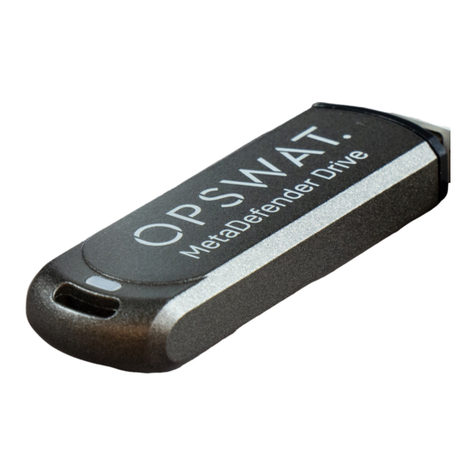
OPSWAT
OPSWAT MetaDefender manual
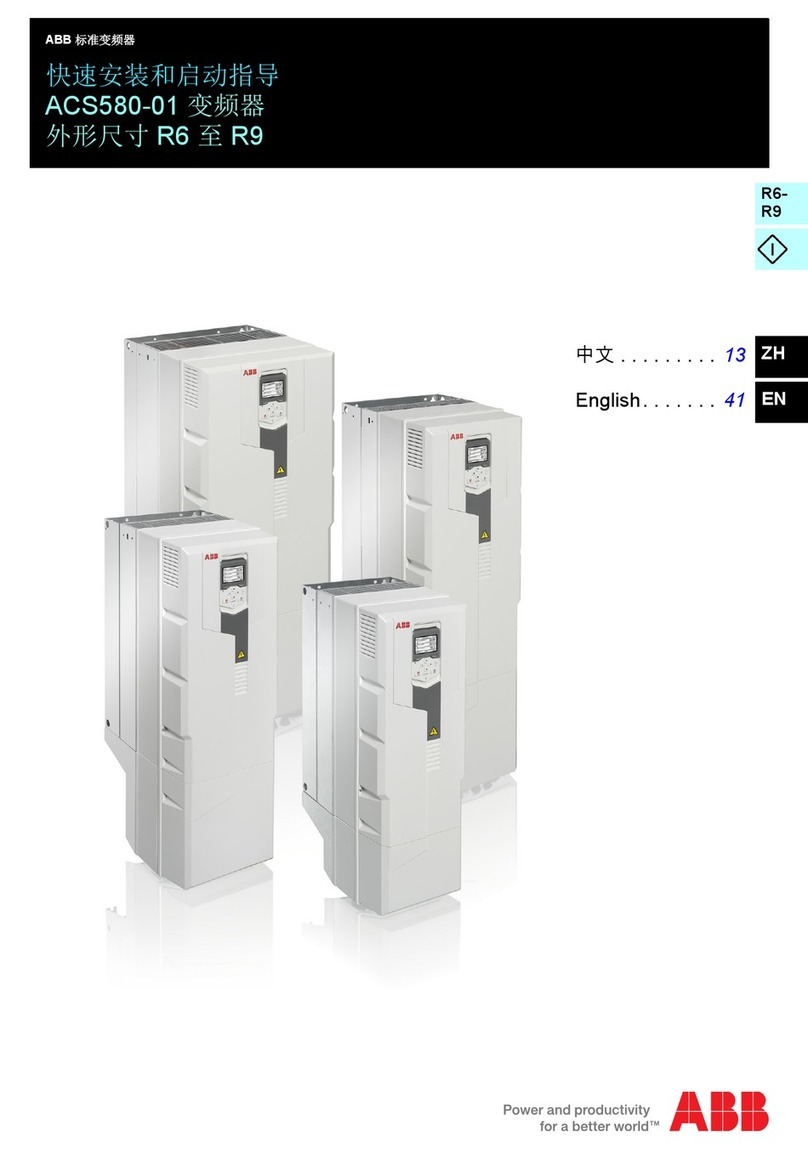
ABB
ABB EN Series Quick installation guide
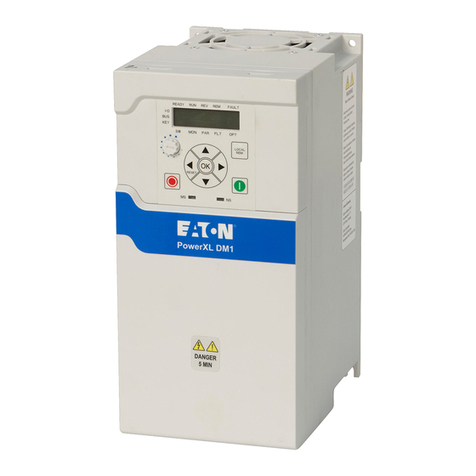
Eaton
Eaton PowerXL DM1 Series Instruction leaflet

GE
GE Fuji Electric FVR-C9S-2UX Series instruction manual

Rockwell Automation
Rockwell Automation Reliance electric GV3000/SE manual

GFA
GFA ELEKTROMAT SI 50.80 FU-55,00 installation instructions
